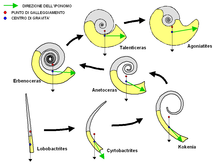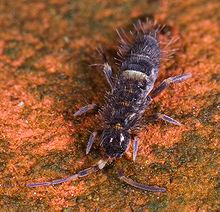Portal:Devonian
The Devonian Portal
The Devonian (/dɪˈvoʊni.ən, dɛ-/ də-VOH-nee-ən, deh-) is a geologic period and system of the Paleozoic era during the Phanerozoic eon, spanning 60.3 million years from the end of the preceding Silurian period at 419.2 million years ago (Ma), to the beginning of the succeeding Carboniferous period at 358.9 Ma. It is named after Devon, South West England, where rocks from this period were first studied.
The first significant evolutionary radiation of life on land occurred during the Devonian, as free-sporing land plants (pteridophytes) began to spread across dry land, forming extensive coal forests which covered the continents. By the middle of the Devonian, several groups of vascular plants had evolved leaves and true roots, and by the end of the period the first seed-bearing plants (pteridospermatophytes) appeared. This rapid evolution and colonization process, which had begun during the Silurian, is known as the Silurian-Devonian Terrestrial Revolution. The earliest land animals, predominantly arthropods such as myriapods, arachnids and hexapods, also became well-established early in this period, after beginning their colonization of land at least from the Ordovician period.
Fishes, especially jawed fish, reached substantial diversity during this time, leading the Devonian to often be dubbed the Age of Fishes. The armored placoderms began dominating almost every known aquatic environment. In the oceans, cartilaginous fishes such as primitive sharks became more numerous than in the Silurian and Late Ordovician. Tetrapodomorphs, which include the ancestors of all four-limbed vertebrates (i.e. tetrapods), began diverging from freshwater lobe-finned fish as their more robust and muscled pectoral and pelvic fins gradually evolved into forelimbs and hindlimbs, though they were not fully established for life on land until the Late Carboniferous. (Full article...)
Selected Devonian Article
The Bactritida are a small order of more or less straight-shelled (orthoconic) cephalopods that first appeared during the Emsian stage of the Devonian period (407 million years ago) with questionable origins in the Pragian stage before 409 million years ago, and persisted until the Carnian pluvial event in the upper middle Carnian stage of the Triassic period (231 million years ago). They are considered ancestors of the ammonoids, as well as of the coleoids (octopus, squid, cuttlefish, and the extinct belemnites).
Bactritids are distinguished from the more primitive nautiloids by the small size and globular shape of the protoconch, the so-called embryonic shell. Nautiloids have relatively large embryonic shells, and living species lay a few large eggs. In contrast, bactritids and ammonoids produced large numbers of small eggs, each housing a small embryonic shell. (Full article...)List of selected Devonian articles
|
|---|
Selected Devonian land plant article
The lycophytes, when broadly circumscribed, are a group of vascular plants that include the clubmosses. They are sometimes placed in a division Lycopodiophyta or Lycophyta or in a subdivision Lycopodiophytina. They are one of the oldest lineages of extant (living) vascular plants; the group contains extinct plants that have been dated from the Silurian (ca. 425 million years ago). Lycophytes were some of the dominating plant species of the Carboniferous period, and included the tree-like Lepidodendrales, some of which grew over 40 metres (130 ft) in height, although extant lycophytes are relatively small plants.
The scientific names and the informal English names used for this group of plants are ambiguous. For example, "Lycopodiophyta" and the shorter "Lycophyta" as well as the informal "lycophyte" may be used to include the extinct zosterophylls or to exclude them. (Full article...)List of selected Devonian articles
|
|---|
Selected Devonian formation
The Traverse Group is a geologic group in Michigan, Indiana and Ohio comprising middle Devonian limestones with calcareous shale components. Its marine fossils notably include Michigan's state stone, the Petoskey stone (the extinct coral Hexagonaria percarinata), among other corals and records of ancient marine life. A range of trilobites has also been found in the Traverse Group.
The Traverse Group outcrops in Emmet and Charlevoix counties along the northwestern shore of Michigan's lower peninsula. Its formations are Gravel Point, Charlevoix Limestone, Petoskey, and Whiskey Creek. The Gravel Point Formation consists of a lithographic gray to brown limestone with shale beds up to 0.5 meters thick; it also includes chert nodules and bioherms (fossilized reef mounds). The Charlevoix Limestone is a mildly argillaceous limestone with interbedded coquina. The Petoskey Formation is an arenaceous limestone named for its locale (Petoskey, Michigan), and contains the eponymous Petoskey stones. The Whiskey Creek Formation is a limestone.
The Traverse Group formed as a shallow carbonate shelf during the Devonian period (~419 to 359 Ma), when the most recent supercontinent, Pangea, was just beginning to take shape. (Full article...)List of selected Devonian formation articles
|
|---|
Selected Devonian fish article

Lepidaspis serrata ("serrated scaley shield") is an extinct heterostracan jawless fish from Early Devonian Canada. Its scientific name refers to the fact that the armor is composed of hundreds of tiny scales with serrated edges.
Although it is regarded as a heterostracan, its exact placement within Heterostraci is regarded as incertae sedis, as the fact that it is currently impossible to discern where its dorsal and ventral plates (which are made up of a mosaic of the aforementioned tiny scales) end or begin. Some experts regard it as being descended from the basal heterostracans of the Silurian. (Full article...)Selected Devonian invertebrate
Springtails (Collembola) form the largest of the three lineages of modern hexapods that are no longer considered insects (the other two are the Protura and Diplura). Although the three orders are sometimes grouped together in a class called Entognatha because they have internal mouthparts, they do not appear to be any more closely related to one another than they are to all insects, which have external mouthparts.
Collembolans are omnivorous, free-living organisms that prefer moist conditions. They do not directly engage in the decomposition of organic matter, but contribute to it indirectly through the fragmentation of organic matter and the control of soil microbial communities. The word Collembola is from the ancient Greek κόλλα kólla "glue" and ἔμβολος émbolos "peg"; this name was given due to the existence of the collophore, which was previously thought to stick to surfaces to stabilize the creature.
Some DNA sequence studies suggest that Collembola represent a separate evolutionary line from the other Hexapoda, but others disagree; this seems to be caused by widely divergent patterns of molecular evolution among the arthropods. The adjustments of traditional taxonomic rank for springtails reflect the occasional incompatibility of traditional groupings with modern cladistics: when they were included with the insects, they were ranked as an order; as part of the Entognatha, they are ranked as a subclass. If they are considered a basal lineage of Hexapoda, they are elevated to full class status. (Full article...)List of selected Devonian invertebrates articles
|
|---|
Need help?
Do you have a question about Devonian that you can't find the answer to?
Consider asking it at the Wikipedia reference desk.
Subcategories
Related portals
Associated Wikimedia
The following Wikimedia Foundation sister projects provide more on this subject:
-
Commons
Free media repository -
Wikibooks
Free textbooks and manuals -
Wikidata
Free knowledge base -
Wikinews
Free-content news -
Wikiquote
Collection of quotations -
Wikisource
Free-content library -
Wikiversity
Free learning tools -
Wiktionary
Dictionary and thesaurus


























